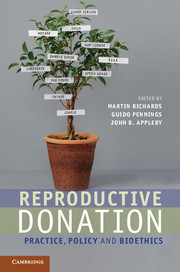Book contents
- Frontmatter
- Contents
- Contributors
- Acknowledgements
- 1 Introduction
- 2 The biology of donation
- 3 Ethics for reproductive donation
- 4 Parenthood – whose right is it anyway?
- 5 Reproductive donation
- 6 UK and US perspectives on the regulation of gamete donation
- 7 Gamete and embryo donation
- 8 The legal and ethical regulation of transnational donation
- 9 Balancing ethical criteria for the recruitment of gamete donors
- 10 Challenges in intra-family donation
- 11 ARTs and the single parent
- 12 Reproductive donation and justice for gay and lesbian couples
- 13 Is disclosure in the best interests of children conceived by donation?
- 14 Identifiable donors and siblings
- 15 Ethical issues in embryo donation
- 16 Reproduction through surrogacy
- 17 Some conclusions regarding the interaction of normative and descriptive elements in reproductive donation
- Index
- References
6 - UK and US perspectives on the regulation of gamete donation
Published online by Cambridge University Press: 05 August 2012
- Frontmatter
- Contents
- Contributors
- Acknowledgements
- 1 Introduction
- 2 The biology of donation
- 3 Ethics for reproductive donation
- 4 Parenthood – whose right is it anyway?
- 5 Reproductive donation
- 6 UK and US perspectives on the regulation of gamete donation
- 7 Gamete and embryo donation
- 8 The legal and ethical regulation of transnational donation
- 9 Balancing ethical criteria for the recruitment of gamete donors
- 10 Challenges in intra-family donation
- 11 ARTs and the single parent
- 12 Reproductive donation and justice for gay and lesbian couples
- 13 Is disclosure in the best interests of children conceived by donation?
- 14 Identifiable donors and siblings
- 15 Ethical issues in embryo donation
- 16 Reproduction through surrogacy
- 17 Some conclusions regarding the interaction of normative and descriptive elements in reproductive donation
- Index
- References
Summary
Introduction
Assisted reproduction (AR) has dramatically changed family formation in Western countries. It has opened access not only to couples battling infertility, but also single individuals and gay and lesbian couples. The United States (USA) and United Kingdom (UK) have taken sharply different regulatory paths regarding AR. While the UK has developed comprehensive regulatory guidance for AR providers based on the work of multidisciplinary commissions, the US legislative scheme is quite limited and fails to address many issues related to gamete donation. It primarily relies on a market model based on private ordering. This chapter investigates these contrasting legal frameworks regarding gamete donation and their ethical contexts. In conducting this evaluation, it must be kept in mind that both regulation and the absence of regulation express ethical perspectives (Pennings, 2004).
While both societies agree that patient autonomy is essential to fertility treatment, the UK seeks to protect the autonomy of all involved through clearly defined government legislation and guidance. It also trumps individual autonomy where it finds that societal values, such as human dignity, override the rights of individuals to make decisions regarding reproduction. The USA has, for the most part, left determinations regarding autonomy to the private sector – medical professionals, market providers and consumers. Most states have little or no regulation, so assisted reproductive choices are not restricted, but there is also less legal certainty regarding the rights of each participant in the process.
- Type
- Chapter
- Information
- Reproductive DonationPractice, Policy and Bioethics, pp. 90 - 111Publisher: Cambridge University PressPrint publication year: 2012
References
- 2
- Cited by



